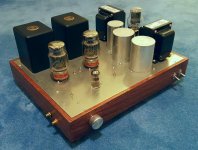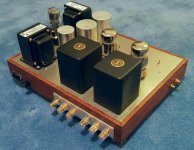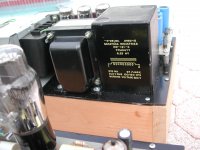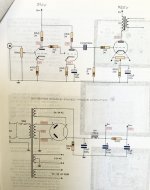That is weird; my transformers I just got were made by a ghost?
Must be his son. I had Jack make me OPT´s in 2008, and the note says he died in 2006.
I also communicated with him in 2012.
Thank you scholl, Francois G, Nightpuma, Audiowize, Tubelab_com, ErikdeBest, invaderzim for the amazing information! Wow there are some impressive looking iron. I thought the 400mA for the 20H choke (per channel) seemed high too... Great suggestions and advice guys!🙌🙌
I’m going to make individual power supplies for each channel. I’ll try AC on the heaters first. According to Derek, hum was 1-2 mV and only audible on 98dB speakers few inches away with AC heaters. Mine are 91dB. It seems using toroidal cores were key.
BTW, this will be my second Amp. The first was the Abdullah 6N1P/KT88 SE Amp with James 123 OPT and Jupiter Cu Coupling Caps. After the 300B, I’d like to build a premium SE 845 or GM70 Amp...
I’m going to make individual power supplies for each channel. I’ll try AC on the heaters first. According to Derek, hum was 1-2 mV and only audible on 98dB speakers few inches away with AC heaters. Mine are 91dB. It seems using toroidal cores were key.
BTW, this will be my second Amp. The first was the Abdullah 6N1P/KT88 SE Amp with James 123 OPT and Jupiter Cu Coupling Caps. After the 300B, I’d like to build a premium SE 845 or GM70 Amp...
Attachments
Attached are a couple shots sent from Monolith as they were building the OPTs, and a shot of one completed mono amp.
AMCC1000! Very, very nice. May i ask what was the price?
Magz, this is perfection and refinement to the max!🙌👏Looks like a world-class instrument!!Monolith makes very fine iron, indeed. My 833C amps have 60lb outputs and high-voltage chokes from Monolith and sound very good indeed.
Attached are a couple shots sent from Monolith as they were building the OPTs, and a shot of one completed mono amp.
AMCC1000! Very, very nice. May i ask what was the price?
They are the SA-833 on their website:
product & prices | MONOLITH MAGNETICS
He said price was no object...
You also have these if price is no object: AUDIOPHILE TAMURA F-5002 Amorphous Core Single End Output Transformers HIGH END | eBay
The power supply operating voltages and stage currents can be deduced from the schematics in post #11 and using PSUD2.
What can't be deduced too well are the DCR's of the power transformer and choke windings. Imho if you were not cutting corners then you would get someone to measure those values in an actual amp before purchasing parts based on an abridged set of parameters.
What can't be deduced too well are the DCR's of the power transformer and choke windings. Imho if you were not cutting corners then you would get someone to measure those values in an actual amp before purchasing parts based on an abridged set of parameters.
Here’s the schematic and power supply for the 300B MkII.
I just don’t know where to find premium transformers. I’ll look into Tango and Lundahl as suggested. Again, I’m not looking to cut corners, it’s all about what’s available regardless of price!
Question: Since I can’t find premium Plitron transformers, can I “substitute” a Toroidy 18H, 250mA choke?
Try the dutch site of Menno van der Veen . He designed the Plitrons and he has contact now with a European manufaturer now.
And having looked at a so called "walton design", I saw the power supply started with a choke after a rectifier: this gives excellent regulation (stabilized HV over quite a level of current) and this needs, requires even, a very strong choke with more current capabilities than the steady current..
I have tried it too, and the choke is prone to mechanical noise (hum) if it is not correctly dimensioned (I tried with 200mA choke and a 2x 4.700 uF 450V cap, well I tend to overstress designs.)
albert
looked at a so called "walton design", I saw the power supply started with a choke after a rectifier
The schematic posted by the OP, however shows a 7uF input cap.
It's true that chokes don't like being the input to the filter. They have to eat a lot more ripple and the peak currents are much higher. These will make any choke run warmer, and those that aren't mechanically sound will buzz.
A choke input filter must not run under light load either. That's not an issue in a class A design, but can be a problem in some push pull amps with light idle currents.
The schematic posted by the OP, however shows a 7uF input cap.
It's true that chokes don't like being the input to the filter. They have to eat a lot more ripple and the peak currents are much higher. These will make any choke run warmer, and those that aren't mechanically sound will buzz.
A choke input filter must not run under light load either. That's not an issue in a class A design, but can be a problem in some push pull amps with light idle currents.
Can you imagine why Walton chose such enormous chokes? I mean 20H/400mA is a monster.
I don't spend much time looking at other people's amp designs, and I know nothing about this one other than the schematic shown earlier in this thread.
There are plenty of reasons to choose a choke or other part that is too big for the job. Some are valid from an engineering perspective, and humming, buzzing, and excess heat are real issues in a choke input filter design. Maybe these were part of the design criteria, or maybe they were not, I have no way of knowing.
Sometimes the choice of parts comes down to aesthetics, or availability. The choke pictured here now lives in my 845SE amplifier. Before that, it lived in my 300Beast. The Beast was a push pull amp running 4 X 300B tubes, and nearly class A, and it DID use a choke input filter primarily to reduce the B+ voltage since the power transformer I used was too big. Both choices were made based on what parts I had in my collection at the time.
This choke is rated at 6.25 H, 205 mA, 67 ohm DCR. It is too small current wise, but military surplus tends to be conservatively rated. There is no hum or buzz, but this thing is filled with epoxy or tar.
There are plenty of reasons to choose a choke or other part that is too big for the job. Some are valid from an engineering perspective, and humming, buzzing, and excess heat are real issues in a choke input filter design. Maybe these were part of the design criteria, or maybe they were not, I have no way of knowing.
Sometimes the choice of parts comes down to aesthetics, or availability. The choke pictured here now lives in my 845SE amplifier. Before that, it lived in my 300Beast. The Beast was a push pull amp running 4 X 300B tubes, and nearly class A, and it DID use a choke input filter primarily to reduce the B+ voltage since the power transformer I used was too big. Both choices were made based on what parts I had in my collection at the time.
This choke is rated at 6.25 H, 205 mA, 67 ohm DCR. It is too small current wise, but military surplus tends to be conservatively rated. There is no hum or buzz, but this thing is filled with epoxy or tar.
Attachments
I don't spend much time looking at other people's amp designs, and I know nothing about this one other than the schematic shown earlier in this thread.
There are plenty of reasons to choose a choke or other part that is too big for the job. Some are valid from an engineering perspective, and humming, buzzing, and excess heat are real issues in a choke input filter design. Maybe these were part of the design criteria, or maybe they were not, I have no way of knowing.
Sometimes the choice of parts comes down to aesthetics, or availability. The choke pictured here now lives in my 845SE amplifier. Before that, it lived in my 300Beast. The Beast was a push pull amp running 4 X 300B tubes, and nearly class A, and it DID use a choke input filter primarily to reduce the B+ voltage since the power transformer I used was too big. Both choices were made based on what parts I had in my collection at the time.
This choke is rated at 6.25 H, 205 mA, 67 ohm DCR. It is too small current wise, but military surplus tends to be conservatively rated. There is no hum or buzz, but this thing is filled with epoxy or tar.
Thanks
If you want to throw a lot of money at the project, Monolith Magnetics or Sowter would be the way to go.
Magnequest does not appear to be winding anymore. I would wonder about Electra-print as well, as I've heard from three different people now that Jack is deceased.
Wow!! that's too bad. I had some great conversations with Jack and Mike.
This talk about the construction requirements for a choke in a choke-input power supply is great, but the OP has provided a schematic that he says he wants to follow, and it depicts a cap-input power supply. The fact that different possibilities for the initial cap are shown is due entirely to the difference in peak voltage and current capabilities of the chosen rectifier tube. It's still cap-input.
Now, if he might change his mind and opt for choke-input, and if he has the funds he seems to possess, he could search for relics from the old days, like maybe an appropriate swinging choke from UTC or one of the other giants of the old industry, and he could learn about things like input and output voltage differences between cap- and choke-input supplies, and critical inductance (and, I guess, swinging chokes). It could be fun, and might even result in a better amp.
Now, if he might change his mind and opt for choke-input, and if he has the funds he seems to possess, he could search for relics from the old days, like maybe an appropriate swinging choke from UTC or one of the other giants of the old industry, and he could learn about things like input and output voltage differences between cap- and choke-input supplies, and critical inductance (and, I guess, swinging chokes). It could be fun, and might even result in a better amp.
Last edited:
You also have these if price is no object: AUDIOPHILE TAMURA F-5002 Amorphous Core Single End Output Transformers HIGH END | eBay
Those would be down the list for me below Sowter and Monolith.
The power supply operating voltages and stage currents can be deduced from the schematics in post #11 and using PSUD2.
What can't be deduced too well are the DCR's of the power transformer and choke windings. Imho if you were not cutting corners then you would get someone to measure those values in an actual amp before purchasing parts based on an abridged set of parameters.
I don’t know what the DCR values are for the obsolete Plitron chokes. Are there vast differences in DCR among toroidal chokes of similar value?
Here’s the Mk1 version of the Walton 300B Amp - a vastly different PS! He used a Hammond choke of lower ohmic value than originally stated in the JE Labs 300B Amp.
Attachments
- Status
- This old topic is closed. If you want to reopen this topic, contact a moderator using the "Report Post" button.
- Home
- Amplifiers
- Tubes / Valves
- Finest Chokes, Power, and Output Transformers



